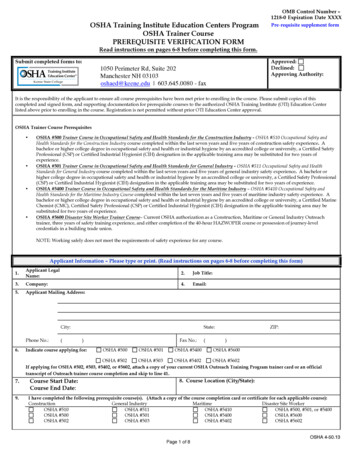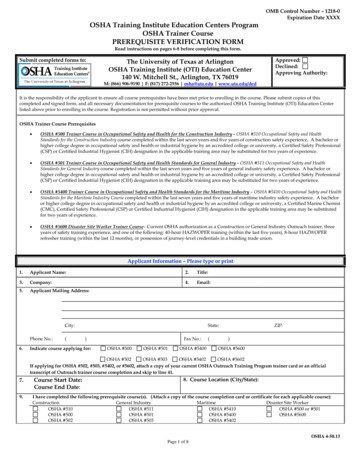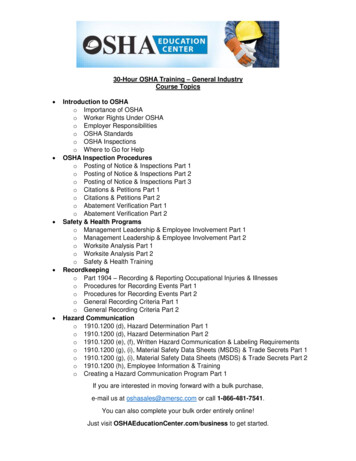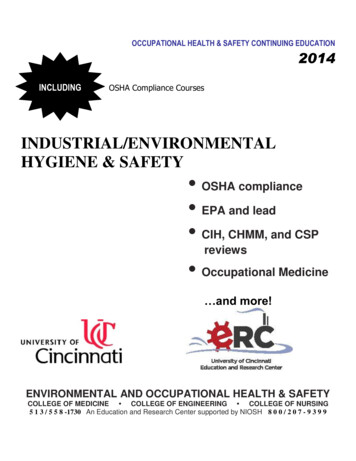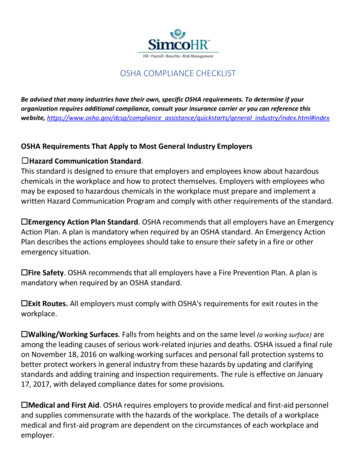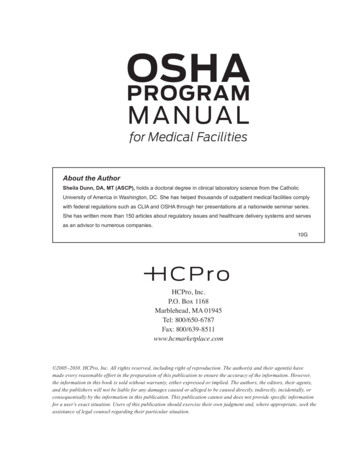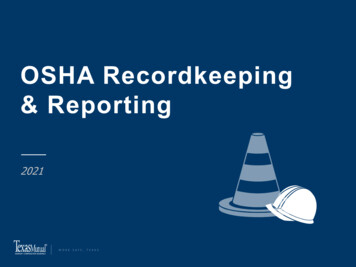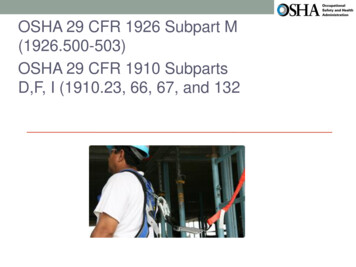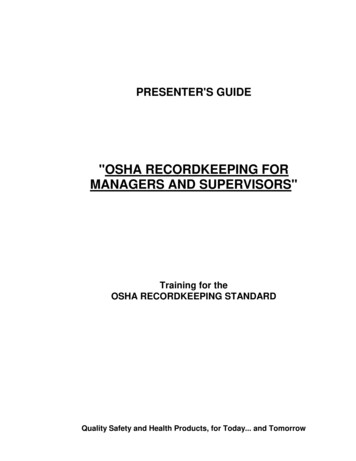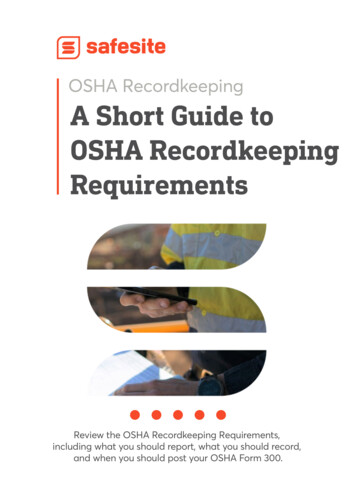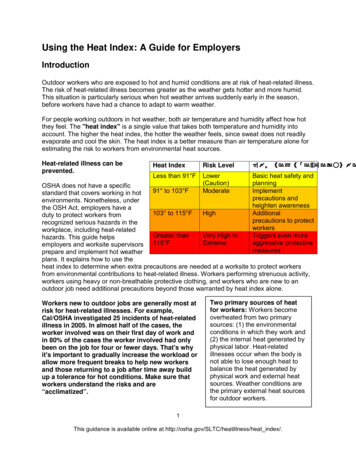
Transcription
Using the Heat Index: A Guide for EmployersIntroductionOutdoor workers who are exposed to hot and humid conditions are at risk of heat-related illness.The risk of heat-related illness becomes greater as the weather gets hotter and more humid.This situation is particularly serious when hot weather arrives suddenly early in the season,before workers have had a chance to adapt to warm weather.For people working outdoors in hot weather, both air temperature and humidity affect how hotthey feel. The "heat index" is a single value that takes both temperature and humidity intoaccount. The higher the heat index, the hotter the weather feels, since sweat does not readilyevaporate and cool the skin. The heat index is a better measure than air temperature alone forestimating the risk to workers from environmental heat sources.Heat-related illness can beprevented.Heat IndexRisk Level3URWHFWLYH 0HDVXUHVLess than 91 FLower(Caution)ModerateBasic heat safety andplanningImplementprecautions andheighten awarenessAdditionalprecautions to protectworkersTriggers even moreaggressive protectivemeasuresOSHA does not have a specific91 to 103 Fstandard that covers working in hotenvironments. Nonetheless, underthe OSH Act, employers have a103 to 115 FHighduty to protect workers fromrecognized serious hazards in theworkplace, including heat-relatedGreater thanVery High tohazards. This guide helpsExtremeemployers and worksite supervisors 115 Fprepare and implement hot weatherplans. It explains how to use theheat index to determine when extra precautions are needed at a worksite to protect workersfrom environmental contributions to heat-related illness. Workers performing strenuous activity,workers using heavy or non-breathable protective clothing, and workers who are new to anoutdoor job need additional precautions beyond those warranted by heat index alone.Workers new to outdoor jobs are generally most atrisk for heat-related illnesses. For example,Cal/OSHA investigated 25 incidents of heat-relatedillness in 2005. In almost half of the cases, theworker involved was on their first day of work andin 80% of the cases the worker involved had onlybeen on the job for four or fewer days. That's whyit's important to gradually increase the workload orallow more frequent breaks to help new workersand those returning to a job after time away buildup a tolerance for hot conditions. Make sure thatworkers understand the risks and are“acclimatized”.Two primary sources of heatfor workers: Workers becomeoverheated from two primarysources: (1) the environmentalconditions in which they work and(2) the internal heat generated byphysical labor. Heat-relatedillnesses occur when the body isnot able to lose enough heat tobalance the heat generated byphysical work and external heatsources. Weather conditions arethe primary external heat sourcesfor outdoor workers.1This guidance is available online at http://osha.gov/SLTC/heatillness/heat index/.
Outdoor workers include any workers who spend a substantial portion of the shiftoutdoors. Examples include construction workers, agricultural workers, baggage handlers,electrical power transmission and control workers, and landscaping and yard maintenanceworkers. These workers are at risk of heat-related illness when the heat index is high.Additional risk factors are listed below. These must be taken into consideration even whenthe heat index is lower. Work in direct sunlightPerform prolonged or strenuous workWear heavy protective clothing or impermeable suits*This guidance is advisory in nature and informational in content. It is not a standard or regulation, and it neithercreates new legal obligations nor alters existing obligations created by OSHA standards or the Occupational Safetyand Health Act. Pursuant to the OSH Act, employers must comply with safety and health standards and regulationsissued and enforced either by OSHA or by an OSHA-approved State Plan. In addition, the Act’s General DutyClause, Section 5(a)(1), requires employers to provide their employees with a workplace free from recognizedhazards likely to cause death or serious physical harm.2This guidance is available online at http://osha.gov/SLTC/heatillness/heat index/.
Using the Heat Index: A Guide for EmployersAbout the Heat IndexThe U.S. National Oceanographic and Atmospheric Administration (NOAA) developed the heatindex system. The heat index combines both air temperature and relative humidity into a singlevalue that indicates the apparent temperature in degrees Fahrenheit, or how hot the weather willfeel. The higher the heat index, the hotter the weather will feel, and the greater the risk thatoutdoor workers will experience heat-related illness. NOAA issues heat advisories as the heatindex rises. To learn more about the heat index, visit NOAA’s website.Why humidity matters: Relative humidity is a measure of the amount of moisture in the air.Sweat does not evaporate as quickly when the air is moist as it does in a dry climate. Sinceevaporation of sweat from the skin is one of the ways the human body cools itself on a hot day,high humidity reduces our natural cooling potential and we feel hotter. Low humidity can also bea problem for outdoor workers in hot, desert-like climates. Sweat evaporates very rapidly in lowhumidity, which can lead to severe dehydration if a person does not drink enough waterthroughout the day.IMPORTANT NOTE: The heat index values were devised for shady, light wind conditions, andexposure to full sunshine can increase heat index values by up to 15 Fahrenheit. Toaccount for solar load, added precautions are recommended. See Protective Measures to Takeat Each Risk Level.3This guidance is available online at http://osha.gov/SLTC/heatillness/heat index/.
NOAA issues extreme heat advisories to indicate when excessive, extended heat willoccur. The advisories are based mainly on predicted heat index values: Excessive Heat Outlook: issued when the potential exists for extended excessiveheat (heat index of 105-110 F) over the next 3-7 days. This is a good time tocheck on supplies, such as extra water coolers, and refresh worker training. Excessive Heat Watch: issued when excessive heat could occur within the next 24to 72 hours, but the timing is uncertain. Excessive Heat Warning: issued when the heat index will be high enough to be lifethreatening in the next 24 hours. This warning indicates that the excessive heatis imminent or has a very high probability of occurring. Excessive Heat Advisory: similar to an Excessive Heat Warning, but less serious.This is issued when the heat index could be uncomfortable or inconvenient, butis not life threatening if precautions are taken.4This guidance is available online at http://osha.gov/SLTC/heatillness/heat index/.
Using the Heat Index: A Guide for EmployersUsing the Heat Index to Protect WorkersThe heat index can be used to help determine the risk of heat-related illness for outdoorworkers, what actions are needed to protect workers, and when those actions are triggered.Depending on the heat index value, the risk for heat-related illness can range from lower to veryhigh to extreme. As the heat index value goes up, more preventive measures are needed toprotect workers. Heat index values are divided into four bands associated with four risk levels.These bands differ from those appearing in the NOAA Heat Index chart, which was developedfor the public. The NOAA bands have been modified for use at worksites:Heat IndexRisk LevelProtective MeasuresLess than 91 FLower (Caution)Basic heat safety and planning91 F to 103 FModerateImplement precautions and heighten awareness103 F to 115 FHighAdditional precautions to protect workersGreater than115 FVery High toExtremeTriggers even more aggressive protectivemeasuresImportant consideration: NOAA devised the heat index values for shadedconditions and light winds. Full sunshine can increase heat index values byup to 15 Fahrenheit. Strenuous work and the use of heavy or specializedprotective clothing also have an additive effect. As a result, the risk at a specificheat index could be higher than that listed in the table above if the work is indirect sunlight without a light breeze, or if work involves strenuous tasks or theuse of heavy or specialized protective clothing. Extra measures, includingimplementing precautions at the next risk level, are necessary under thesecircumstances.The employer’s response at the four risk levels is the subject of the remainder of this guide. Thesteps employers should take in response to an elevated heat index are the same type of stepsthat they would follow to address other hazards in the workplace: Develop an illness prevention plan for outdoor work based on the heat index Train your workers how to recognize and prevent heat-related illness Track the worksite heat index daily; communicate it and the required precautions toworkers Implement your plan; review and revise it throughout the summer5This guidance is available online at http://www.osha.gov/SLTC/heatillness/heat index/.
STEP 1: Develop a heat-related illness prevention plan before heat index levels rise.Use the Protective Measures to Take at Each Risk Level to inform your planning. The planshould address:Heat Index Risk LevelPlan upplies (ensuring adequatewater, provisions for rest areas,and other supplies)Emergency planning andresponse (preparing supervisorsand crews for emergencies)Worker acclimatization(gradually increasing workloads;allowing more frequent breaksas workers adapt to the heat)Modified work schedules(establishing systems to enableadjustments to work schedules)Training (preparing workers torecognize heat-related illnessand preventive measures)Physiological, visual, and verbalmonitoring (using directobservation and physiologicalmonitoring to check for signs ofheat-related illness)Review the pages of this guide to learn more about what you can do to protect workers fromheat-related illness. Use checklists to assist in planning ahead and in daily planning.STEP 2: Train workers before it gets hot. Train workers about safe work practices beforeheat index levels go up. Prepare workers so that they recognize the signs and symptoms ofheat-related illness, how to prevent it, and what to do if someone has symptoms. Reinforce thetraining on hot days.For heat-related illness prevention training tools and resources, go to TrainingResources. OSHA’s factsheets and worksite posters (in English and Spanish) can helpin communicating key messages about heat safety and health.6This guidance is available online at http://www.osha.gov/SLTC/heatillness/heat index/.
STEP 3: Track the weather for the worksite daily and assess the risk to workers. Knowhow hot it will be during scheduled work activities and use this information to determine whichpreventive measures should be taken.Check with the National Weather Service to get the current or predicted heat indexvalues and see a map of areas under excessive heat warning across the U.S. The heatindex is also announced by television and radio stations as part of the local weather.Monitor weather reports daily to remain prepared for high heat index levels. Monitorweather reports daily to remain prepared for high heat index levels. Use OSHA's HeatSmartphone App to check the heat index for your worksite and see reminders about theprotective measures for the specified risk level.STEP 4: Implement your plan when the heat index is at or above 80 Fahrenheit. Adjustrisk level based on site conditions (direct sunlight vs. shaded, with breeze), work load, and typeof protective clothing.See Summary of Employer Actions at each risk level.7This guidance is available online at http://www.osha.gov/SLTC/heatillness/heat index/.
Using the Heat Index: A Guide for EmployersProtective Measures to Take at Each Risk LevelUse the protective measures described for each risk level to help you plan ahead, and scheduleand train your workers so that everyone is prepared to work safely as the heat index rises.Actions for Low Risk Conditions: Heat Index Less Than 91 FActions for Moderate Risk Conditions: Heat Index is 91 F to 103 FActions for High Risk Conditions: Heat Index is 103 F to 115 FActions for Very High to Extreme Risk Conditions: Heat Index Greater Than 115 FSummary of Risk Levels and Associated Protective MeasuresThe most critical actions employers should take to help prevent heat-related illness at each risklevel:Heat IndexRisk Level 91 FLower(Caution)Protective Measures Provide drinking waterEnsure that adequate medical services areavailablePlan ahead for times when heat index is higher,including worker heat safety trainingEncourage workers to wear sunscreenIf workers must wear heavy protective clothing,perform strenuous activity or work in the direct sun,additional precautions are recommended to protectworkers from heat-related illness.*91 F to 103 FModerateIn addition to the steps listed above: Remind workers to drink water often (about 4cups/hour)**Review heat-related illness topics with workers:how to recognize heat-related illness, how toprevent it, and what to do if someone gets sickSchedule frequent breaks in cool, shaded areaAcclimatize workersSet up buddy system/instruct supervisors towatch workers for signs of heat-related illnessIf workers must wear heavy protective clothing,perform strenuous activity or work in the direct sun,additional precautions are recommended to protectworkers from heat-related illness.*8This guidance is available online at http://www.osha.gov/SLTC/heatillness/heat index/.
103 F to 115 F HighSchedule activities at a time when the heatindex is lowerDevelop work/rest schedulesMonitor workers closelyIn addition to the steps listed above: Alert workers of high risk conditionsActively encourage workers to drink plenty ofwater (about 4 cups/hour)**Limit physical exertion (e.g. use mechanical lifts)Have a knowledgeable person at the worksitewho is well-informed about heat-related illnessand able to determine appropriate work/restschedulesEstablish and enforce work/rest schedulesAdjust work activities (e.g., reschedule work,pace/rotate jobs)Use cooling techniquesWatch/communicate with workers at all timesWhen possible, reschedule activities to a time whenheat index is lower 115 FVery High toExtremeReschedule non-essential activity for days with areduced heat index or to a time when the heat indexis lowerMove essential work tasks to the coolest part of thework shift; consider earlier start times, split shifts, orevening and night shifts. Strenuous work tasks andthose requiring the use of heavy or non-breathableclothing or impermeable chemical protectiveclothing should not be conducted when the heatindex is at or above 115 F.If essential work must be done, in addition to the stepslisted above: Alert workers of extreme heat hazardsEstablish water drinking schedule (about 4cups/hour)**Develop and enforce protective work/restschedulesConduct physiological monitoring (e.g., pulse,temperature, etc)Stop work if essential control methods are9This guidance is available online at http://www.osha.gov/SLTC/heatillness/heat index/.
inadequate or unavailable.*The heat index is a simple tool and a useful guide for employers making decisions aboutprotecting workers in hot weather. It does not account for certain conditions that contributeadditional risk, such as physical exertion. Consider taking the steps at the next highest risklevel to protect workers from the added risks posed by: Working in the direct sun (can add up to 15 F to the heat index value)Wearing heavy clothing or protective gear**Under most circumstances, fluid intake should not exceed 6 cups per hour or 12 quartsper day. This makes it particularly important to reduce work rates, reschedule work, orenforce work/rest schedules.10This guidance is available online at http://www.osha.gov/SLTC/heatillness/heat index/.
Using the Heat Index: A Guide for EmployersActions for Lower (Caution) Risk Conditions: Heat Index is Less Than91 FMost people can work safely when the heat index is 91 F with only basic measures for workersafety and health, as required by the OSH Act. As minimum measures, employers have a dutyto: Provide adequate amounts of drinking water in convenient, visible locations close tothe work area. Ensure that adequate medical services are available. Where medical services (e.g.,emergency medical services, clinic, hospital) are not available within 3-4 minutes, haveappropriately trained personnel and adequate medical supplies on site. The trainedpersonnel should have a valid certificate in first aid training from the American RedCross or equivalent training. (A first aid certificate is required at maritime andconstruction worksites.)Additional precautions are advisable based on site conditions, work load, and protective clothinguse: Take actions described for Moderate Risk Conditions (91 F - 103 F) if heat index isclose to 91 F OR work is being conducted in direct sunshine or without a lightbreeze. Follow additional precautions for workers wearing heavy or non-breathableclothing or impermeable chemical protective clothing because they are at greaterrisk even when the risk to other workers is lower. Workers in heavy, non-breathable or"impermeable" protective clothing canHeatRiskProtectiveexperience heat-related illness atIndexLevelMeasurestemperatures as low as 70 F. Monitorthem closely for signs of heat-relatedLess than LowerBasic heat safetyillness and see the section on Taking91 F(Caution)and planningAdded Precautions for High RiskConditions.Implement91 F toprecautions andAcclimatize new and returningModerate103 Fheightenworkers performing strenuous work.awarenessThese individuals may be at high riskfor heat-related illness, even when theAdditional103 F toheat index is low.Highprecautions to115 Fprotect workersCheck the weather forecast regularlyTriggers even morein warm seasons to learn if more extremeVery HighGreateraggressivehot weather conditions are predicted.tothan 115 FprotectiveMake sure your hot weather plans are inExtrememeasuresplace and that workers are trained before 11This guidance is available online at http://www.osha.gov/SLTC/heatillness/heat index/.
hot outdoor work begins. Train workers on how to recognize symptoms of heat-relatedillness, individual risk factors for heat-related illness, how to prevent it, and what to do ifsomeone has symptoms so they are prepared when hotter, higher-risk work conditionsarise. Encourage workers to wear sunscreen and use other protections from directsunlight. Provide shade, hats, and sunscreen, when possible. Sunburn reduces theskin's ability to release excess heat, making the body more susceptible to heat-relatedillness.Drinking WaterWater should have a palatable (pleasant and odor-free) taste andwater temperature should be 50 F to 60 F, if possible.Sanitation standard 29 CFR 1910.141 requires that employersprovide "potable water" at work sites, which is water that meetsthe drinking water standards of the state or local authority havingjurisdiction, or water that meets the quality standards prescribedby the U.S. EPA’s drinking water regulations (40 CFR Part 141).12This guidance is available online at http://www.osha.gov/SLTC/heatillness/heat index/.
Using the Heat Index: A Guide for EmployersActions for Moderate Risk Conditions: Heat Index is 91 F to 103 FAt the moderate risk level some precautions in addition to those already mentioned are neededto prevent heat-related illness. Review heat-related illness signs and precautions with workers.Remind workers to drink water. Provide workers opportunities to rest in cool, shaded areas. Beaware of conditions that could increase risk. Alert workers to the heat index anticipated for the day and identify eachprecaution in place at the work site to reduce the risk of heat-related illness. Provide adequate amounts of cool water and disposable cups in convenient, visiblelocations close to the work area. Remind workers to drink small amounts of water often (before they become thirsty).A good rule of thumb is to drink about 4 cups of water every hour when the heat indexsuggests a moderate risk level. Ensure that adequate medical services are available. Where medical services (e.g.,emergency medical services, clinic, hospital) are not available within 3-4 minutes, youmust have appropriately trained personnel and adequate medical supplies on site. Thetrained personnel should have a valid certificate in first aid training from the AmericanRed Cross or equivalent training. (A first aid certificate is required at maritime andconstruction worksites.) Respond to heat-related illness and medical emergencies without delay. Workerswho show symptoms of heat-related illness need immediate attention. Treatingmilder symptoms (headache, weakness) early by providing rest in a shaded areaand cool water to drink canprevent a more serious medicalHeatProtectiveRisk Levelemergency. Call 911 immediatelyIndexMeasuresif a worker loses consciousnessLess than LowerBasic heat safetyor appears confused or(Caution)and planninguncoordinated. These are signs of 91 Fpossible heat stroke. Heat strokeImplementis fatal if not treated immediately.91 F toprecautions andModerate103 FheightenReview heat-related illness signsawarenessand symptoms and site-specificprecautions during daily meetingsAdditional103 F toor toolbox talks. Be sure everyoneHighprecautions to115 Fknows procedures for responding toprotect workerspossible heat-related illness.Triggers even moreGreaterVery High toaggressive What steps to follow if athan115 FExtremeprotectiveworker exhibits signs andmeasuressymptoms of heat-related illness13This guidance is available online at http://www.osha.gov/SLTC/heatillness/heat index/.
Who to call for medical helpWho will provide first aid until the ambulance arrivesThe resources under Educational Resources are useful training tools for dailymeetings and toolbox talks. Schedule frequent rest breaks in cool, shaded areas.Provide air conditioned or shaded areas close to the work area.Set up temporary shade when working in open fields or areas without easyaccess to shade or air conditioning. Acclimatize new and returning workers. Gradually increase the workload or allowmore frequent breaks to help new and returning workers build up a tolerance for hotconditions over time. If the heat index increases suddenly, allow all workers morefrequent breaks for a few days while they become accustomed to the warmerconditions. Implement actions for the High Risk Conditions (103 F - 115 F) if heat indexapproaches 103 F OR work is strenuous, in direct sunlight, or involves the use ofheavy or non-breathable clothing or impermeable chemical protective clothing. Set up a buddy system, if possible, to enable workers to look out for signs andsymptoms of heat-related illness in each other. Often, a worker will not recognize hisown signs and symptoms. Instruct supervisors to watch workers for signs of heat-related illness. Checkroutinely to make sure workers are making use of water and shade and not experiencingheat-related symptoms. Encourage workers to wear sunscreen and use other protections from directsunlight. Provide shade, hats, and sunscreen, when possible. Sunburn reduces theskin's ability to release excess heat, making the body more susceptible to heat-relatedillness. Repeated overexposure to sunlight also leads to skin cancer.Drinking WaterWater should have a palatable (pleasant and odor-free) taste and watertemperature should be 50 F to 60 F, if possible.Other DrinksEncourage workers to choose water over soda and other drinks containingcaffeine and high sugar content. These drinks may lead to dehydration. Drinkswith some flavoring added may be more palatable to workers and thereby improvehydration. Encourage workers to avoid drinking alcohol during hot weather.14This guidance is available online at http://www.osha.gov/SLTC/heatillness/heat index/.
Using the Heat Index: A Guide for EmployersActions for High Risk Conditions: Heat Index is 103 F to 115 FAs the heat index rises above 103 F, there is a high risk for heat-related illness, so additionalmeasures to protect workers are needed. Increase rest periods and designate a knowledgeableperson (well-informed on heat-related illness) at the worksite to determine appropriate work/restschedules. Reduce work load and pace strenuous work tasks. Remind workers to drink plenty ofwater every 15 to 20 minutes. Alert workers to the heat index anticipated for the day and identify eachprecaution in place at the work site to reduce the risk of heat-related illness.Review heat-related illness signs and symptoms during daily meetings or toolbox talks.Be sure everyone knows procedures for responding to possible heat-related illness. What steps to follow if a worker exhibits signs and symptoms of heat-relatedillnessWho to call for medical helpHow to give clear directions to the worksiteWho will provide first aid until the ambulance arrivesThe resources under Educational Resources are useful training tools for dailymeetings and toolbox talks. Provide plenty of cool drinking water and disposable cups in convenient, visiblelocations close to the work area. Actively encourage workers to drinksmall amounts of water often (beforethey become thirsty). They should drinkabout 4 cups of water every hour while theheat index is 103 to 115 F. Workers willneed the greatest amount of water if theymust work in direct sunshine, during peakexertion, and during the hottest part of theday.Under most circumstances extendedhourly fluid intake should not exceed 6cups per hour or 12 quarts per day. Tomaintain worker hydration, it is particularlyimportant to reduce work rates, reschedulework for a time when the heat index islower, or enforce work/rest scheduleswhen work must continue during periods ofextreme risk for heat-related illness.HeatIndexRiskLevelLess than91 FLowerBasic heat safety(Caution) and planning91 F to103 FImplementprecautions andModerateheightenawareness103 F to115 FHighVeryGreaterHigh tothan 115 FExtremeProtectiveMeasuresAdditionalprecautions toprotect workersTriggers evenmore aggressiveprotectivemeasures15This guidance is available online at http://www.osha.gov/SLTC/heatillness/heat index/.
Ensure that adequate medical services are available. Where medical services (e.g.,emergency medical services, clinic, hospital) are not available within 3-4 minutes, haveappropriately trained personnel and adequate medical supplies on site. The trainedpersonnel should have a valid certificate in first aid training from the American RedCross or equivalent training. (A first aid certificate is required at maritime andconstruction worksites.) Respond to heat-related illness andmedical emergencies without delay.Workers who show symptoms of heatrelated illness need immediateattention. Treating milder symptoms(headache, weakness) early byproviding rest in a shaded area andcool water to drink can prevent a moreserious medical emergency. Call 911immediately if a worker losesconsciousness or appears confused oruncoordinated. These are signs ofpossible heat stroke. Heat stroke isfatal if not treated immediately.Drinking WaterWater should have a palatable(pleasant and odor-free) taste andwater temperature should be 50 Fto 60 F, if possible.Other DrinksEncourage workers to choose waterover soda and other drinkscontaining caffeine and high sugarcontent. These drinks may lead todehydration. Drinks with someflavoring added may be morepalatable to workers and therebyimprove hydration. Encourageworkers to avoid drinking alcoholduring hot weather events. Have a knowledgeable person onsitewho is well-informed about heat-relatedillness and authorized to modify workactivities and the work/rest schedule asneeded. Establish and enforce work/rest schedules to control heat exposure and allowworkers to recover. Take into account the level of physical exertion and type ofprotective equipment being used. Advise workers of the work/rest schedule and make sure supervisors enforcerest breaks.Provide air conditioned or cool, shaded areas close to the work area for breaksand recovery periods.Set up temporary shade when working in open fields or areas without easyaccess to shade or air conditioning.Adjust work activities to help reduce worker risk: Schedule heavy tasks earlier in the day or at a time during the day when theheat index is lower. Consider adjusting the work shift to allow for earlier starttimes, or evening and night shifts.Where possible, set up shade canopies over work areas in direct sunshine ormove jobs that can be moved to naturally shaded areas.Permit only those workers acclimatized to heat to perform the morestrenuous tasks. Rotate physically demanding job tasks among acclimatizedworkers.16This guidance is available online at http://www.osha.gov/SLTC/heatillness/heat index/.
Decrease the physical demands and pace of jobs. If heavy job tasks cannotbe avoided, change work/rest cycles to increase the amount of rest time.Add extra personnel to physically demanding tasks so that the shared workload is less intense. This will lower the workers’ risk of heat-related illness.Rotate workers to job tasks that are less strenuous or in cooler/airconditioned setting for part of the work shift.Acclimatize workers. Take steps that help all workers become acclimatized to the heat,particularly if the weather turns hot suddenly. Gradually increase workloads and allowmore frequent breaks during the first week of work. Closely supervise new employeesfor the first 14 days, until they are fullyacclimatized.Workers are at an increased risk ofTake actions described for the Very Highheat stress from personalto Extreme Risk Conditions ( 115 F) ifprotective equipment (PPE),heat index approaches 115 F AND theespecially from wearing semiwork is being conducted in directpermeable
creates new legal obligations nor alters existing obligations created by OSHA standards or the Occupational Safety and Health Act. Pursuant to the OSH Act, employers must comply with safety and health standards and regulations issued and enforced either by OSHA or by an OSHA-approved State Plan. In addition, the Act's General Duty
